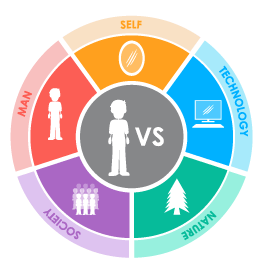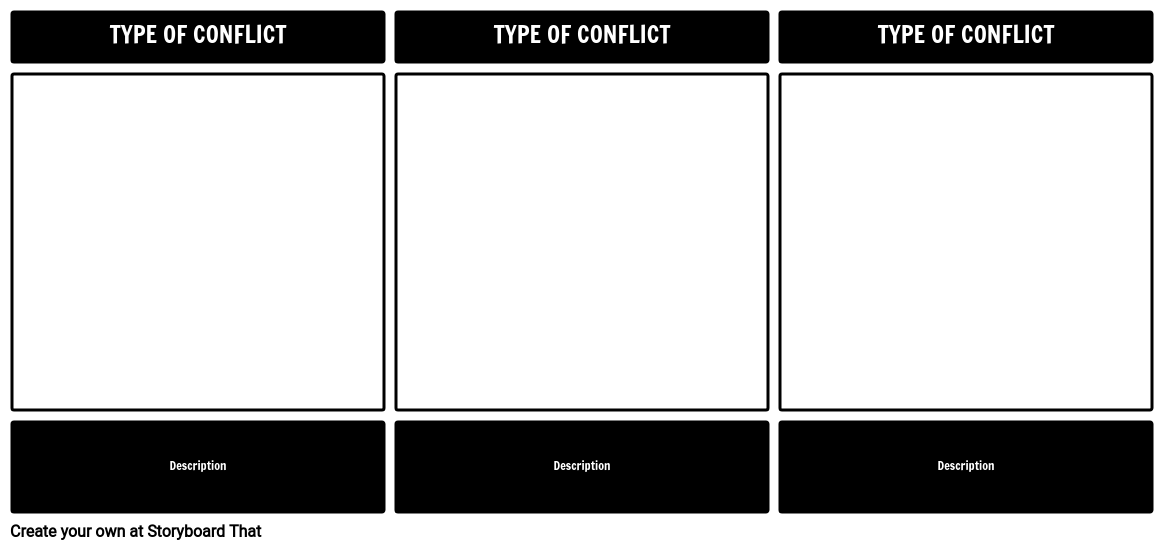Lesson Plan Overview
Storyboarding is an excellent way to focus on types of literary conflict. Have your students choose an example of each literary conflict and depict them using the Storyboard Creator.
In the storyboard, an example of each conflict should be visually represented, along with an explanation of the scene, and how it fits the particular category of conflict.
Examples of Literary Conflict from Richard III
Character vs. Character
Richard asks Lord Buckingham to kill the two young princes in the Tower of London. For the first time, Buckingham hesitates at Richard’s orders because the request is so heinous. Richard believes that Buckingham is weak and cannot be trusted, and Buckingham realizes he’s fallen out of favor with Richard. He flees to Wales and raises an army against Richard; however, he is captured, and Richard eventually has Buckingham beheaded.
Character vs. Self
As Richard goes to sleep the night before battle, he is visited by the ghosts of those whom he has killed: Prince Edward, Henry VI, Clarence, Rivers, Grey, Vaughan, the Princes, Hastings, Anne, and Buckingham. When Richard awakes, he is terrified, and realizes he hates himself, that he is guilty of murder, and that it is time to despair over what he has done.
Character vs. Society
The people of England do not want Richard to be crowned king. While Buckingham tries to drum up support for a Richard III bid for the throne, the people all recognize Richard for what he really is: a dangerous man. Richard’s deeds and reputation precede him, and the people do not want him as their king.
Template and Class Instructions
(These instructions are completely customizable. After clicking "Copy Activity", update the instructions on the Edit Tab of the assignment.)
Student Instructions
Create a storyboard that shows at least three forms of literary conflict in Richard III.
- Identify conflicts in Richard III.
- Categorize each conflict as Character vs. Character, Character vs. Self, Character vs. Society, Character vs. Nature, or Character vs. Technology.
- Illustrate conflicts in the cells, using characters from the story.
- Write a short description of the conflict below the cell.
Lesson Plan Reference
Student Rubric
(You can also create your own on Quick Rubric.)
| Proficient | Emerging | Beginning | Try Again | |
|---|---|---|---|---|
| Conflict Identification | Student identifies correct major conflicts and uses strong, clear textual evidence to support choice. | Student identifies correct major conflict and uses few or unclear details to support their choice. | Student identifies incorrect major conflict, and uses some details from the text to support their choice. | Student does not attempt to identify major conflict or identifies incorrect major conflict with no explanation. |
| Understanding Outcome | Student clearly shows the outcome of the conflict and its effects on the protagonist with evidence from the text. | Student shows the outcome of the conflict and its effect on the protagonist, but some evidence is unclear. | Student shows the outcome of the conflict, but does not examine its effect on the protagonist and uses some vague textual evidence. | Student does not clearly show the outcome of the conflict or use textual evidence. |
| Character | Storyboard includes all required characters and clearly names them. Goes above and beyond by adding additional details. | Storyboard includes all required characters and clearly names them. | Storyboard includes protagonist and antagonist but leaves out other required characters. | Storyboard does not include the names of required characters. |
| Storyboard | Student clearly shows effort to convey the setting the scene of the book | Student attempts to convey setting and scene of the book, but lacks some clarity. | Student does not clearly convey the setting and scene. | Student makes little or no attempt to convey the setting or scene. |
| Spelling and Grammar | Student uses exemplary spelling and grammar. There are no errors. | Student makes a minor error in spelling and grammar. | Student makes several minor errors in spelling and grammar. | Student makes many errors in spelling and grammar; little attempt at spellchecking. |
Lesson Plan Overview
Storyboarding is an excellent way to focus on types of literary conflict. Have your students choose an example of each literary conflict and depict them using the Storyboard Creator.
In the storyboard, an example of each conflict should be visually represented, along with an explanation of the scene, and how it fits the particular category of conflict.
Examples of Literary Conflict from Richard III
Character vs. Character
Richard asks Lord Buckingham to kill the two young princes in the Tower of London. For the first time, Buckingham hesitates at Richard’s orders because the request is so heinous. Richard believes that Buckingham is weak and cannot be trusted, and Buckingham realizes he’s fallen out of favor with Richard. He flees to Wales and raises an army against Richard; however, he is captured, and Richard eventually has Buckingham beheaded.
Character vs. Self
As Richard goes to sleep the night before battle, he is visited by the ghosts of those whom he has killed: Prince Edward, Henry VI, Clarence, Rivers, Grey, Vaughan, the Princes, Hastings, Anne, and Buckingham. When Richard awakes, he is terrified, and realizes he hates himself, that he is guilty of murder, and that it is time to despair over what he has done.
Character vs. Society
The people of England do not want Richard to be crowned king. While Buckingham tries to drum up support for a Richard III bid for the throne, the people all recognize Richard for what he really is: a dangerous man. Richard’s deeds and reputation precede him, and the people do not want him as their king.
Template and Class Instructions
(These instructions are completely customizable. After clicking "Copy Activity", update the instructions on the Edit Tab of the assignment.)
Student Instructions
Create a storyboard that shows at least three forms of literary conflict in Richard III.
- Identify conflicts in Richard III.
- Categorize each conflict as Character vs. Character, Character vs. Self, Character vs. Society, Character vs. Nature, or Character vs. Technology.
- Illustrate conflicts in the cells, using characters from the story.
- Write a short description of the conflict below the cell.
Lesson Plan Reference
Student Rubric
(You can also create your own on Quick Rubric.)
| Proficient | Emerging | Beginning | Try Again | |
|---|---|---|---|---|
| Conflict Identification | Student identifies correct major conflicts and uses strong, clear textual evidence to support choice. | Student identifies correct major conflict and uses few or unclear details to support their choice. | Student identifies incorrect major conflict, and uses some details from the text to support their choice. | Student does not attempt to identify major conflict or identifies incorrect major conflict with no explanation. |
| Understanding Outcome | Student clearly shows the outcome of the conflict and its effects on the protagonist with evidence from the text. | Student shows the outcome of the conflict and its effect on the protagonist, but some evidence is unclear. | Student shows the outcome of the conflict, but does not examine its effect on the protagonist and uses some vague textual evidence. | Student does not clearly show the outcome of the conflict or use textual evidence. |
| Character | Storyboard includes all required characters and clearly names them. Goes above and beyond by adding additional details. | Storyboard includes all required characters and clearly names them. | Storyboard includes protagonist and antagonist but leaves out other required characters. | Storyboard does not include the names of required characters. |
| Storyboard | Student clearly shows effort to convey the setting the scene of the book | Student attempts to convey setting and scene of the book, but lacks some clarity. | Student does not clearly convey the setting and scene. | Student makes little or no attempt to convey the setting or scene. |
| Spelling and Grammar | Student uses exemplary spelling and grammar. There are no errors. | Student makes a minor error in spelling and grammar. | Student makes several minor errors in spelling and grammar. | Student makes many errors in spelling and grammar; little attempt at spellchecking. |
How Tos about Literary Conflict in Richard III
Design a literary conflict anchor chart with your students
Create a visual anchor chart listing the main types of literary conflict—such as Character vs. Character, Character vs. Self, and Character vs. Society—using examples from Richard III. This helps students quickly reference and remember each conflict type during lessons.
Introduce each conflict type with a relatable classroom scenario
Begin by describing a simple, everyday situation for each conflict type (e.g., two classmates disagreeing = Character vs. Character) before connecting it to Richard III. This builds understanding by linking literary concepts to students’ real lives.
Guide students to identify conflicts in short excerpts
Read or display brief excerpts from Richard III and ask students to determine which conflict type is present. Encourage them to explain their reasoning, fostering critical thinking and engagement with the text.
Model creating a conflict storyboard together
Collaboratively fill in one cell of a storyboard as a class. Select a memorable conflict from Richard III, draw simple sketches or use character cutouts, and write a short scene description. This demonstrates expectations and sparks creativity.
Support students as they storyboard their own conflict examples
Allow students to choose scenes or invent their own examples, then create storyboard cells showing each conflict type. Circulate to offer feedback, ensuring students accurately identify and illustrate the conflicts.
Frequently Asked Questions about Literary Conflict in Richard III
What are the main types of literary conflict in Richard III?
Richard III features several types of literary conflict, including Character vs. Character (e.g., Richard vs. Buckingham), Character vs. Self (Richard’s internal guilt and despair), and Character vs. Society (Richard against the people of England who reject his rule).
How can I teach literary conflict in Richard III using storyboards?
To teach literary conflict in Richard III with storyboards, have students select scenes that illustrate conflicts, categorize them (like Character vs. Character), and visually depict each scene with a brief written explanation. Storyboarding helps students analyze and organize conflict types clearly.
What is an example of character vs. self conflict in Richard III?
An example of character vs. self conflict in Richard III is when Richard is haunted by the ghosts of his victims before battle. He wakes up feeling terrified and guilty, realizing the full weight of his crimes against others and himself.
Why is understanding literary conflict important for students studying Richard III?
Understanding literary conflict helps students analyze characters’ motivations and the play’s themes. In Richard III, recognizing conflicts deepens comprehension of the plot, character development, and Shakespeare’s message about power and morality.
What storyboard activity can help students identify conflict in Richard III?
A helpful activity is to assign students to create a storyboard showing at least three types of conflict in Richard III, such as Character vs. Character, Character vs. Self, and Character vs. Society, with illustrations and short descriptions for each scene.
More Storyboard That Activities
Tragedy of Richard III, The
Testimonials

“By using the product, they were so excited and they learned so much...”–K-5 Librarian and Instructinal Technology Teacher

“I'm doing a Napoleon timeline and I'm having [students] determine whether or not Napoleon was a good guy or a bad guy or somewhere in between.”–History and Special Ed Teacher

“Students get to be creative with Storyboard That and there's so many visuals for them to pick from... It makes it really accessible for all students in the class.”–Third Grade Teacher
© 2026 - Clever Prototypes, LLC - All rights reserved.
StoryboardThat is a trademark of Clever Prototypes, LLC, and Registered in U.S. Patent and Trademark Office








